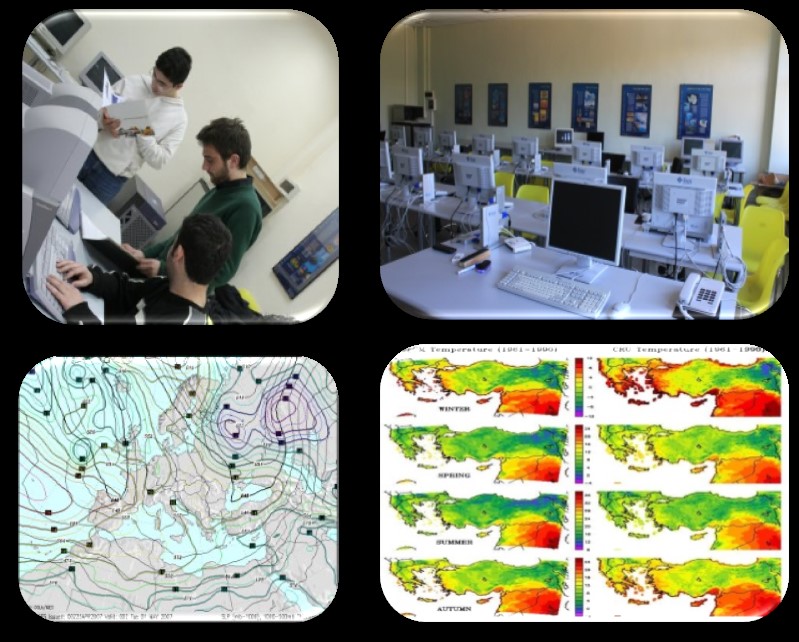Purpose of Laboratory
Our laboratory was established to ensure that the cycle of data analysis - model generation - model testing, which is required for the education of modern meteorological engineering students, is transferred to the students in the most efficient way and in a way that covers the latest technological developments.
Objective of Laboratory
Analysis and display of real-time meteorological data and weather forecast modeling using Meteorology Modeling and Analysis Laboratory are explained to students. It has been used in the educational studies of undergraduate and graduate students since 2001.
Research and Application Fields
All kinds of modeling and data analysis applications related to atmospheric sciences are carried out. These are the modeling and analysis of climate change over the past and future periods, modeling and analysis of short and medium range meteorological forecasts, and studies on determination, modeling and analysis of air quality.
Facilities
Dell Linux workstation and 17 Sun Ray thin clients connected to server; 6 computers; data storage servers; 3 Linux workstations; Sun Blade and Sun Ray servers. During their studies, students have the opportunity to run climate and weather forecast models (ICTP-RegCM4, WRF) by using parallel programming libraries, C/C++ and Fortran compilers, NetCDF and other data libraries installed on the server, and to analyze with data analysis and visualization packages.
Major Studies
-
Analyzing the simulations of specific (flood, heat waves, drought) atmospheric conditions and the physical and dynamic processes that cause them using atmospheric models;
-
Air quality simulations using atmospheric and chemistry models;
-
Regional climate modeling: present-day and future simulations;
-
Statistical modelling;
-
Weather analysis and short-term prediction;
-
Analysis of atmospheric observations using statistical and dynamic methods;
-
Visualization of 2D and 3D data using existing graphics packages in the laboratory.
Several Projects Concluded in the Last 10 Years
-
Kısa Vadeli Rüzgar Enerjisi Tahmin Sistemi, TÜBİTAK, 2010-2013
-
Yüksek Çözünürlükteki Bölgesel İklim Modeli Simülasyonu İle Ekstrem İklim İndekslerinin Belirlenmesi, Türkiye Ulusal Jeodezi ve Jeofizik Birliği, 2013-2015
-
Akdeniz Havzası İkliminin Bölgesel İklim Modeli Kullanılarak Belirlenmesi, İTÜ BAP, 2012-2016
-
Fırat-Dicle Havzasında Yüksek Çözünürlüklü Hidrometeorolojik, Hidrolik ve Su Kalitesi Modellemesi ve Hidroekonomik Analiz Projesi, Hidrometeorolojik Modelleme Raporu, T.C. Orman ve Su İşleri Bakanlığı, Türkiye Su Enstitüsü (SUEN), Temmuz 2016
-
Brewer-Dobson Sirkülasyonunun Geçmiş ve Gelecek Değişimlerinin İklime Etkisinin 3 Boyutlu Olarak İncelenmesi, TÜBİTAK, 113Y545, 2014-2016
-
Local climate change in 3 cities (Cairo, Nairobi, Istanbul) with different population, urban structure, land use classification and climate characteristics and compare different adaptation strategies to local climate change in these cities, EU ERA-NET, TÜBİTAK ERAfrica, 114Y047, 2014-2018
-
The New European Wind Atlas (NEWA), EU ERA-NET, TÜBİTAK, 215M386, 2015-2019
-
Yaz Mevsimindeki Deniz Yüzey Sicakliklarinin Karadeniz Bölgesindeki Şiddetli Yağişlara Etkisinin Atmosfer Modelleri Kullanilarak İncelenmesi, Türkiye Ulusal Jeodezi ve Jeofizik Birliği, 2017-2019
-
Akdeniz Üzerindeki Uzun Dönem Dalga Klimatolojisinin Bölgesel Yer Sistem Modeli İle Belirlenmesi, İTÜ BAP, 2016-2020
-
Anlık Görselleştirme Yaklaşımı Ve Birleşik Atmosfer-Okyanus Model Sisteminin Entegre Edilerek Atmosfer-Denizetkileşimindeki Hızlı Süreçlerin Araştırılması, TÜBİTAK 1001, 2017-2020
-
Karadeniz Deniz Yüzey Sıcaklığının Şiddetli Yağışlara Etkisi Hopa-Artvin Seli, İTÜ BAP, 2018-2020
